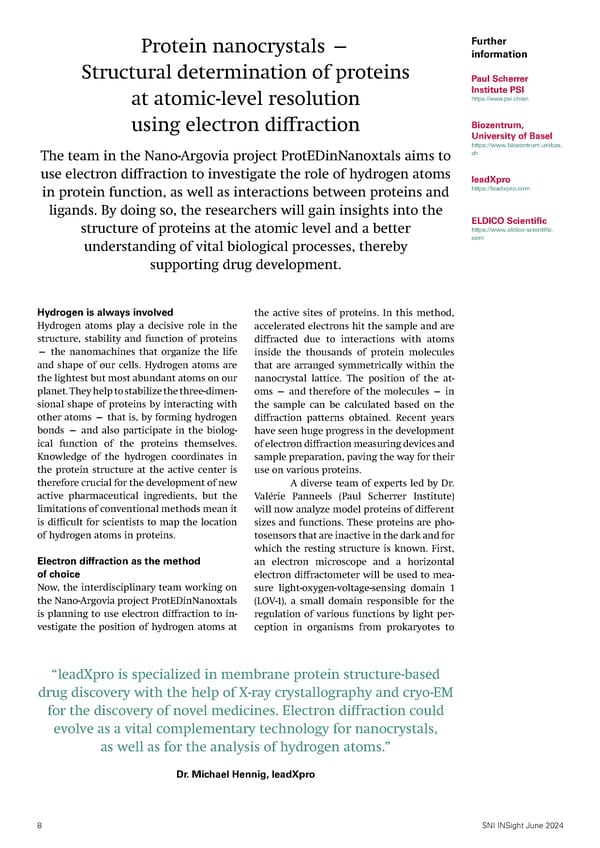Protein nanocrystals — Further information Structural determination of proteins Paul Scherrer Institute PSI at atomic-level resolution https://www.psi.ch/en using electron di昀昀raction Biozentrum, University of Basel https://www.biozentrum.unibas. The team in the Nano-Argovia project ProtEDinNanoxtals aims to ch use electron di昀昀raction to investigate the role of hydrogen atoms leadXpro in protein function, as well as interactions between proteins and https://leadxpro.com ligands. By doing so, the researchers will gain insights into the ELDICO Scientific structure of proteins at the atomic level and a better https://www.eldico-scientific. understanding of vital biological processes, thereby com supporting drug development. Hydrogen is always involved the active sites of proteins. In this method, Hydrogen atoms play a decisive role in the accelerated electrons hit the sample and are structure, stability and function of proteins di昀昀racted due to interactions with atoms — the nanomachines that organize the life inside the thousands of protein molecules and shape of our cells. Hydrogen atoms are that are arranged symmetrically within the the lightest but most abundant atoms on our nanocrystal lattice. The position of the at- planet. They help to stabilize the three-dimen- oms — and therefore of the molecules — in sional shape of proteins by interacting with the sample can be calculated based on the other atoms — that is, by forming hydrogen di昀昀raction patterns obtained. Recent years bonds — and also participate in the biolog- have seen huge progress in the development ical function of the proteins themselves. of electron di昀昀raction measuring devices and Knowledge of the hydrogen coordinates in sample preparation, paving the way for their the protein structure at the active center is use on various proteins. therefore crucial for the development of new A diverse team of experts led by Dr. active pharmaceutical ingredients, but the Valérie Panneels (Paul Scherrer Institute) limitations of conventional methods mean it will now analyze model proteins of di昀昀erent is di昀케cult for scientists to map the location sizes and functions. These proteins are pho- of hydrogen atoms in proteins. tosensors that are inactive in the dark and for which the resting structure is known. First, Electron diffraction as the method an electron microscope and a horizontal of choice electron di昀昀ractometer will be used to mea- Now, the interdisciplinary team working on sure light-oxygen-voltage-sensing domain 1 the Nano-Argovia project ProtEDinNanoxtals (LOV-1), a small domain responsible for the is planning to use electron di昀昀raction to in- regulation of various functions by light per- vestigate the position of hydrogen atoms at ception in organisms from prokaryotes to “leadXpro is specialized in membrane protein structure-based drug discovery with the help of X-ray crystallography and cryo-EM for the discovery of novel medicines. Electron di昀昀raction could evolve as a vital complementary technology for nanocrystals, as well as for the analysis of hydrogen atoms.” Dr. Michael Hennig, leadXpro 8 SNI INSight June 2024
 SNI INSight June 2024 Page 7 Page 9
SNI INSight June 2024 Page 7 Page 9